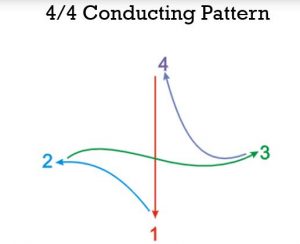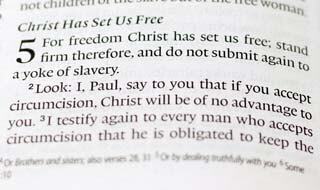 Orchestra members recognize the importance of following the conductor. As a trumpet and French Horn player, I have fond memories of many concert experiences. Our high school band marched in halftime shows (at football games), parades and gave concerts. At Florida Bible College I was a member of the orchestra, and then began a two year adventure as a member of a traveling Christian music group–The Internationals. Our concert tour included hundreds of locations across the United States Canada and Europe. One thing all these concert experiences had in common–we needed to follow the conductor.[1]
Orchestra members recognize the importance of following the conductor. As a trumpet and French Horn player, I have fond memories of many concert experiences. Our high school band marched in halftime shows (at football games), parades and gave concerts. At Florida Bible College I was a member of the orchestra, and then began a two year adventure as a member of a traveling Christian music group–The Internationals. Our concert tour included hundreds of locations across the United States Canada and Europe. One thing all these concert experiences had in common–we needed to follow the conductor.[1]
If you look in a church hymnal (admittedly, harder to find these days) and, for example, see the music for “What a Friend We Have in Jesus,” you’ll observe that the key signature is 4/4 time (four beats per measure). In conducting this song, the hand gestures of the song leader would use a conducting pattern of 1,2,3,4. These strokes of the leader’s hand are repeated throughout the song. The concept of a conducting pattern can also illustrate how the Holy Spirit directs the child of God to abide in Christ day by day. Consider them with me. [2]
 Conductor Stroke 1: Humble yourself
Conductor Stroke 1: Humble yourself
In order to abide in Christ our first response needs to be humility. We are not to be solo instruments that ignore the need for a Conductor.
“Be clothed with humility, for ‘God resists the proud, But gives grace to the humble.’ Therefore humble yourselves under the mighty hand of God, that He may exalt you in due time” (1 Peter 5:5b,6; See James 4:6). Although we have a natural tendency toward pride and self sufficiency, life‘s circumstances and God‘s Word call us to humble ourselves.
Conductor Stroke 2: Yield yourself
The next response is to yield to God’s will. The ‘music’ we play is scripted by the One who has made us His instruments and has planned good works that we should perform them (Eph. 2:10). The Holy Spirit as Conductor leads us in the tempo of His plan and in harmony with His purposes.
Romans 12:1,2 summons us to yield to God’s wise, benevolent leadership. “I appeal to you therefore, brothers, by the mercies of God, to present your bodies as a living sacrifice, holy and acceptable to God, which is your spiritual worship. Do not be conformed to this world, but be transformed by the renewal of your mind, that by testing you may discern what is the will of God, what is good and acceptable and perfect” (ESV). This yielding to God‘s will needs to be manifested in our physical behavior: “And do not present your members as instruments of unrighteousness to sin, but present yourselves to God as being alive from the dead, and your members as instruments of righteousness to God” (Rom. 6:13). As the hymn puts it, our attitude should be “I surrender all.”
Conductor Stroke 3: Trust in God
The next response in the grace conducting pattern is to trust in the Holy Spirit’s enablement. The Grace Conductor not only prompts us externally, but He also inspires us from within.
The Spirit of God leads us to radically depend on the indwelling Christ to live His life in us and through us, instead of us. Paul exemplified living by this pattern: “I have been crucified with Christ [that is, in Him I have shared His crucifixion]; it is no longer I who live, but Christ lives in me. The life I now live in the body I live by faith [by adhering to, relying on, and completely trusting] in the Son of God, who loved me and gave Himself up for me” (Galatians 2:20 Amplified Bible). Instead of depending on our own resources and coping strategies, we are to depend wholeheartedly on God’s grace and enablement.
Miles Stanford observed, “Contrary to general opinion, there is no place for self-confidence in the Christian life. Confidence is essential, but not from the source of self. The awakened believer is so keenly aware of the sinful self-life that, for him, self-confidence is out of the question. In time, his ‘O wretched man’ complex is replaced by “I thank God through Jesus Christ our Lord” (Rom. 7:24, 25). Christ-confidence is the basis for the healthy Christian’s walk.”[3]
For many religious people, trusting God’s grace for living is counterintuitive. We think that living for God is about trying harder. The Lord Jesus was asked, “’What shall we do, that we may work the works of God?’ Jesus answered and said to them, ‘This is the work of God, that you believe in Him whom He sent’” (John 6:28,29). As evangelicals we are adamant that salvation is by grace through faith (Eph. 2:8,9), but too often we assume that sanctification is based on works. However, living as a disciple is a grace through faith walk (See Col. 2:6; Gal. 5:5).
Conductor Stroke 4: Worship God
As the Holy Spirit leads us to humble ourselves, yield, and trust, this leads us to worship God. Worship is the acknowledgment and promotion of God’s glory. “Therefore, whether you eat or drink, or whatever you do, do all to the glory of God” (1 Cor. 10:31). Our Lord used the illustration of us being a light in a dark world: “Let your light so shine before men, that they may see your good works and glorify your Father in heaven” (Matt. 5:16).
Now let’s test this illustration. Is this fourfold response contained in Christ’s teaching on the Vine and branches in John 15:1-8?
As the Gardener, God is the “conductor.”
1. Apart from the Vine, the branch is just a piece of firewood (John 15:6). -humility
2. The branch does not function independently of the Vine (John 15:4). – yielding
3. The branch is fully dependent on the life of the Vine to produce the fruit (John 15:5). – trust
4. The Gardener is glorified by the fruit produced by the Vine through the branches (John 15:8). – worship
How is this fourfold response supremely demonstrated by the Lord Jesus Christ as the Son of Man? Behold:
1. Christ’s supreme humility in His incarnation, servanthood and crucifixion (Phil 2:5-8)
2. Christ’s supreme delight in God’s will (John 4:34; Heb 10:7,9).
3. Christ’s supreme trust in the Father’s care and the Spirit’s power (Psalm 22:9,10; John 5:19,30)
4. Christ’s supreme glorification of the Father (John 12:26; 17:1,5)
In light of Christ’s example of responsiveness, the apostle John draws this implication for the believer: “He who says he abides in Him [Jesus Christ] ought himself also to walk just as He walked” (1 John 2:6).
Note: This Grace Conductor Pattern illustration does not convey all there is to the Christian life, and is not to be a legalistic mechanism. Yet, this fourfold response can be a simple, memorable, practical way to facilitate abiding in Christ.
Although I still miss some cues and play some ‘wrong notes,’ since the Lord revealed this illustration to me, it has been helpful and well-received. In an online Bible study on this topic, one of the participants testified that this teaching had become life-changing for him. After explaining the illustration to a fellow believer, she declared “This reminds me of the sign of the Cross!” Although not a sacramental gesture, the pattern does seem to fit with the principles of the daily cross (Luke 9:23).
Fellow believer, I invite you to prayerfully experiment with these four guidelines. Whether or not you’re musically inclined, you are a member of God’s ‘Orchestra’. The Holy Spirit is the ‘Grace Conductor’ Who holds the baton of Truth, tapping the music stand of our circumstances to get our attention. Let’s tune our hearts to God, follow His direction, and live in harmony with His plan.

















